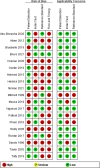Diagnostic accuracy of telemedicine for detection of surgical site infection: a systematic review and meta-analysis
- PMID: 35922663
- PMCID: PMC9349203
- DOI: 10.1038/s41746-022-00655-0
Diagnostic accuracy of telemedicine for detection of surgical site infection: a systematic review and meta-analysis
Abstract
The Sars-CoV-2 pandemic catalysed integration of telemedicine worldwide. This systematic review assesses it's accuracy for diagnosis of Surgical Site Infection (SSI). Databases were searched for telemedicine and wound infection studies. All types of studies were included, only paired designs were taken to meta-analysis. QUADAS-2 assessed methodological quality. 1400 titles and abstracts were screened, 61 full text reports were assessed for eligibility and 17 studies were included in meta-analysis, mean age was 47.1 ± 13.3 years. Summary sensitivity and specificity was 87.8% (95% CI, 68.4-96.1) and 96.8% (95% CI 93.5-98.4) respectively. The overall SSI rate was 5.6%. Photograph methods had lower sensitivity and specificity at 63.9% (95% CI 30.4-87.8) and 92.6% (95% CI, 89.9-94.5). Telemedicine is highly specific for SSI diagnosis is highly specific, giving rise to great potential for utilisation excluding SSI. Further work is needed to investigate feasibility telemedicine in the elderly population group.
© 2022. The Author(s).
Conflict of interest statement
J.T., G.S. and I.C. were co-authors on one study included in the meta-analysis. The authors declare no competing financial interests.
Figures






Similar articles
-
The diagnostic test accuracy of telemedicine for detection of surgical site infection: A systematic review protocol.PLoS One. 2022 Nov 17;17(11):e0263549. doi: 10.1371/journal.pone.0263549. eCollection 2022. PLoS One. 2022. PMID: 36395267 Free PMC article.
-
Universal screening for SARS-CoV-2 infection: a rapid review.Cochrane Database Syst Rev. 2020 Sep 15;9(9):CD013718. doi: 10.1002/14651858.CD013718. Cochrane Database Syst Rev. 2020. PMID: 33502003 Free PMC article.
-
Telemedicine for Surgical Site Infection Diagnosis in Rural Rwanda: Concordance and Accuracy of Image Reviews.World J Surg. 2022 Sep;46(9):2094-2101. doi: 10.1007/s00268-022-06597-8. Epub 2022 Jun 4. World J Surg. 2022. PMID: 35665833
-
Topical antimicrobial prophylaxis in colorectal surgery for the prevention of surgical wound infection: a systematic review and meta-analysis.Tech Coloproctol. 2018 Aug;22(8):573-587. doi: 10.1007/s10151-018-1814-1. Epub 2018 Jul 17. Tech Coloproctol. 2018. PMID: 30019145
-
Use of photograph-based telemedicine in postoperative wound assessment to diagnose or exclude surgical site infection.J Wound Care. 2018 Mar 2;27(3):128-135. doi: 10.12968/jowc.2018.27.3.128. J Wound Care. 2018. PMID: 29509108
Cited by
-
A Practical Approach to Predicting Surgical Site Infection Risk Among Patients Before Leaving the Operating Room.Cureus. 2023 Jul 18;15(7):e42085. doi: 10.7759/cureus.42085. eCollection 2023 Jul. Cureus. 2023. PMID: 37602114 Free PMC article.
-
Acceptability of telemedicine for early surgical site infection diagnosis after cesarean delivery in rural Rwanda: a qualitative study.Matern Health Neonatol Perinatol. 2025 Feb 5;11(1):3. doi: 10.1186/s40748-024-00200-9. Matern Health Neonatol Perinatol. 2025. PMID: 39905451 Free PMC article.
-
Postoperative remote first care for financially and environmentally sustainable healthcare.NPJ Digit Med. 2025 May 21;8(1):299. doi: 10.1038/s41746-025-01585-3. NPJ Digit Med. 2025. PMID: 40399460 Free PMC article.
-
Machine Learning Approaches for the Image-Based Identification of Surgical Wound Infections: Scoping Review.J Med Internet Res. 2024 Jan 18;26:e52880. doi: 10.2196/52880. J Med Internet Res. 2024. PMID: 38236623 Free PMC article.
-
Completion of Recommended Tests and Referrals in Telehealth vs In-Person Visits.JAMA Netw Open. 2023 Nov 1;6(11):e2343417. doi: 10.1001/jamanetworkopen.2023.43417. JAMA Netw Open. 2023. PMID: 37966837 Free PMC article.
References
-
- Centres for Disease Control and Prevention (CDC). Surgical Site Infection (SSI) Event, https://www.cdc.gov/nhsn/pdfs/pscmanual/9pscssicurrent.pdf (2017).
-
- Woelber E., Schrick E. J., Gessner B. D. & Evans H. L. Proportion of surgical site infections occuring after hospital discharge: a systematic review. Surgical Infections17, 10.1089/sur.2015.241 (2016). - PubMed
LinkOut - more resources
Full Text Sources
Miscellaneous

